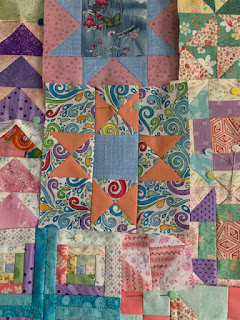There are many different names for this technique that I am about to share with you. I call my version Kaleidoscope quilt and it all starts with one piece of fabric. I didn't take a class or anything, so didn't know exactly what to expect, but I saw this somewhere a long time ago.
This is a piece of Kaffe Fassett fabric, in his usual very colourful theme. Not sure what it really is, but to me, I am remind of snail shells, by the spiral shape. This fabric has a repeat every 21", though I am sure you could used bigger or smaller. If you are looking for something to follow, I know that Jordan Fabrics has a pattern where she goes over how to make a similar quilt, minus the sashing that I made.
Basically, you need to find out what your repeat is and multiply that size by 6, to determine the amount of fabric you need. If you want a bigger quilt, you may have to double that amount, as you always need 6 repeats. You will also need a 60 degree triangle ruler.
You will cut out 6 repeats exactly on the same spot. Once you have those cut out, take them all and stack them on top of each other. Pick a spot on the pattern that you can poke a pin through all the layers, in the same spot, so that they are all positioned exactly the same. This last part is important to make the design work.
Next you will cut strips from your repeat. I cut my strips 3.5" wide by the width of fabric. Keep them all together in the same position. You are going to want to cut carefully with your 60 degree triangle ruler, first upright and after upside down, until you cut the whole strip.
As the cut pieces measure the same on all three sides, you will have three different options on the design that you settle with, when making your hexagon shape. After they are cut, keep the identical stack together. you can separate the pieces and match the points in the centre, when you place them side by side. Make sure the centre of each are all the same (see pictures below for examples).
I know these are bright.......ok, very bright and not what I was expecting, but there you have it. One of my wedges turned out to make this kaleidoscope design. If you want to know where this comes from, look above at the fabric piece. this little section is located on the bottom right hand side, right on the crease in the fabric that I didn't iron before I took the picture. Can you see the pink snail shell on the crease, the blue shell to the left of it and the yellow one just above them? That is the section that this wedge came from. Doesn't look at all like the fabric any more, does it?
The above hexagon comes from the pink and brown shell close to the top centre section of the fabric. This wedge picked up the small orange shell above the dark pink shell plus the yellow shell above the orange one. Quite different! So I am sure you get the idea. Try and see if you can figure out where this next block comes from.
Can't find it.........sorry.......that would be a trick question, as this wedge section is on the other side of the folded fabric.........lol......sorry.......I didn't mean to do that, but left it in here anyways.
As mentioned above, these hexagons are very bright and loud. Once I placed them side by side it was chaos. I just couldn't handle it. That is why this quilt sat aside for the longest time. I just couldn't handle the chaos. Eventually it came to me, that if I separated the blocks with a sashing, it would tone down the overall pattern, hence why I added the dark brown 1/2" finished sashing around each block.
This is what you get when all the hexagon blocks are assembled into a quilt top! I didn't have any repeats, because I only used the one set of repeats. Enlarge the picture and check out all the different designs that are made.
It is amazing how different they are and they all came from the same piece of fabric. This quilt is going to Project Linus. Some child is going to love the bright colours, as children always do.
Take care everyone!









